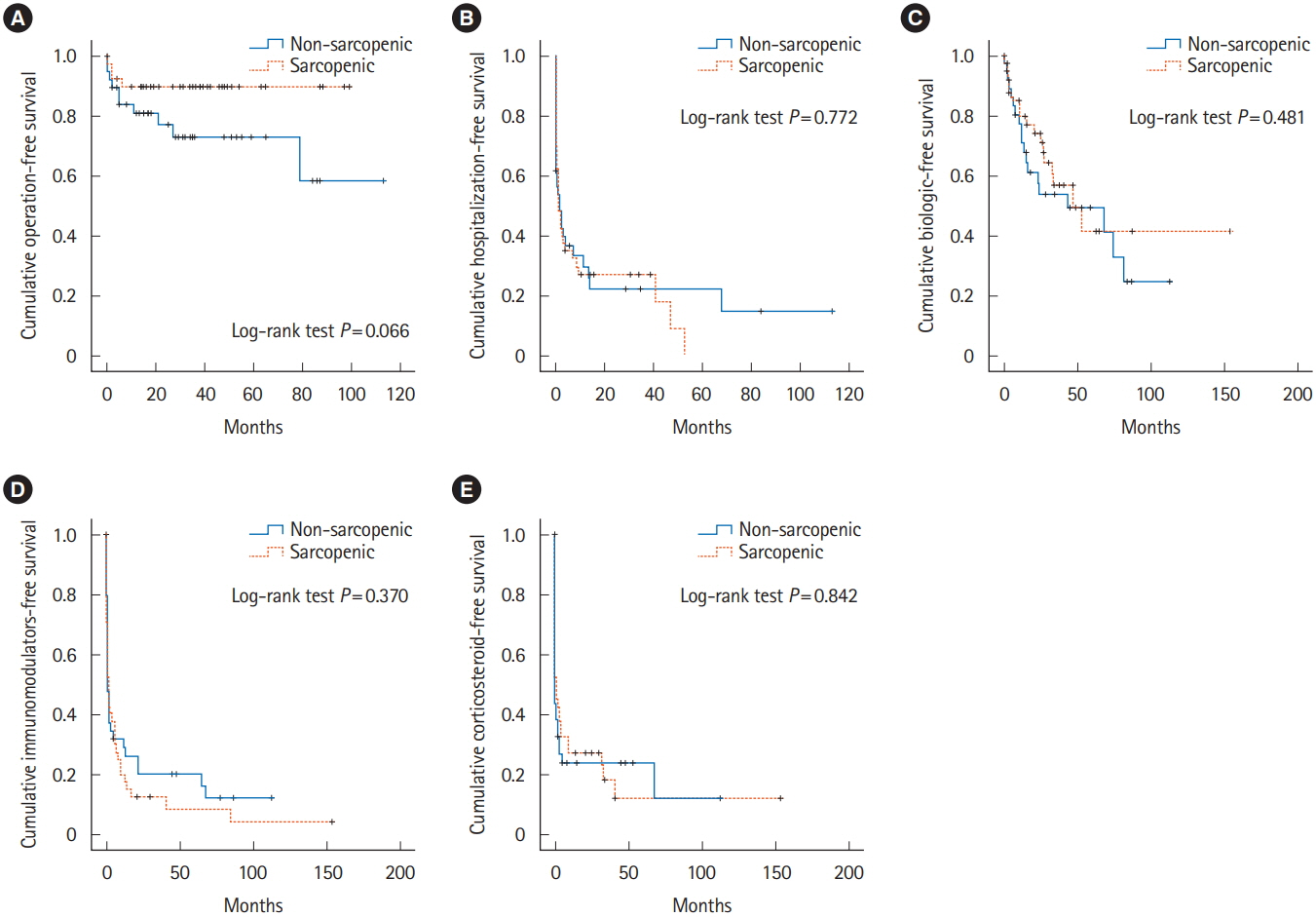Intest Res.
2020 Jan;18(1):79-84. 10.5217/ir.2019.00107.
The prevalence of sarcopenia and its effect on prognosis in patients with Crohn’s disease
- Affiliations
-
- 1Department of Internal Medicine and Liver Research Institute, Seoul National University College of Medicine, Seoul, Korea
- 2Department of Internal Medicine, Seoul National University Bundang Hospital, Seongnam, Korea
- KMID: 2501369
- DOI: http://doi.org/10.5217/ir.2019.00107
Abstract
- Background/Aims
Crohn’s disease is associated with altered body composition, such as low muscle mass, which can affect clinical outcomes. However, there are few studies regarding the effect of sarcopenia on prognosis of Crohn’s disease. In this study, we evaluated the body composition at the initial diagnosis of Crohn’s disease and analyzed the clinical meaning of sarcopenia.
Methods
We conducted a retrospective review of medical records of patients who were diagnosed as Crohn’s disease and underwent computed tomography within 3 months after diagnosis. Sarcopenia was defined as an L3 skeletal muscle index (SMI) of < 49 cm2/m2 for men and < 31 cm2/m2 for women. Outcomes such as need for hospitalization, surgery, use of steroids, immunomodulators and biologics were analyzed.
Results
A total of 79 patients (male, 73.4%; mean age, 29.9 years) were included and 40 patients (51%) were diagnosed as sarcopenia. C-reactive protein (CRP) level was correlated with sarcopenia (P= 0.044). Erythrocyte sedimentation rate (ESR) showed a tendency to decrease inversely with SMI (r = –0.320, P= 0.008) and hemoglobin and albumin tended to increase in proportion to SMI (hemoglobin: r = 0.271, P= 0.016 and albumin: r = 0.350, P= 0.002). However, there was no statistically significance in time-to-first-event analysis in aspects of sarcopenia.
Conclusions
Approximately 50% of patients with newly diagnosed as Crohn’s disease had sarcopenia. CRP levels were higher in the sarcopenia group and SMI correlated with ESR, hemoglobin, and albumin. However, none of prognostic values were demonstrated.
Keyword
Figure
Reference
-
1. Lakatos L, Lakatos PL. Is the incidence and prevalence of inflammatory bowel diseases increasing in Eastern Europe? Postgrad Med J. 2006; 82:332–337.
Article2. Canavan C, Abrams KR, Mayberry JF. Meta-analysis: mortality in Crohn’s disease. Aliment Pharmacol Ther. 2007; 25:861–870.
Article3. Dieleman LA, Heizer WD. Nutritional issues in inflammatory bowel disease. Gastroenterol Clin North Am. 1998; 27:435–451.
Article4. Hebuterne X, Filippi J, Schneider SM. Nutrition in adult patients with inflammatory bowel disease. Curr Drug Targets. 2014; 15:1030–1038.
Article5. Ling SC, Griffiths AM. Nutrition in inflammatory bowel disease. Curr Opin Clin Nutr Metab Care. 2000; 3:339–344.
Article6. Fielding RA, Vellas B, Evans WJ, et al. Sarcopenia: an undiagnosed condition in older adults: current consensus definition: prevalence, etiology, and consequences. International working group on sarcopenia. J Am Med Dir Assoc. 2011; 12:249–256.
Article7. Janssen I, Heymsfield SB, Ross R. Low relative skeletal muscle mass (sarcopenia) in older persons is associated with functional impairment and physical disability. J Am Geriatr Soc. 2002; 50:889–896.
Article8. Shachar SS, Williams GR, Muss HB, Nishijima TF. Prognostic value of sarcopenia in adults with solid tumours: a meta-analysis and systematic review. Eur J Cancer. 2016; 57:58–67.
Article9. Zhang T, Cao L, Cao T, et al. Prevalence of sarcopenia and its impact on postoperative outcome in patients with Crohn’s disease undergoing bowel resection. JPEN J Parenter Enteral Nutr. 2017; 41:592–600.
Article10. Pedersen M, Cromwell J, Nau P. Sarcopenia is a predictor of surgical morbidity in inflammatory bowel disease. Inflamm Bowel Dis. 2017; 23:1867–1872.
Article11. Adams DW, Gurwara S, Silver HJ, et al. Sarcopenia is common in overweight patients with inflammatory bowel disease and may predict need for surgery. Inflamm Bowel Dis. 2017; 23:1182–1186.
Article12. Bamba S, Sasaki M, Takaoka A, et al. Sarcopenia is a predictive factor for intestinal resection in admitted patients with Crohn’s disease. PLoS One. 2017; 12:e0180036.
Article13. Holt DQ, Strauss BJ, Lau KK, Moore GT. Body composition analysis using abdominal scans from routine clinical care in patients with Crohn’s Disease. Scand J Gastroenterol. 2016; 51:842–847.
Article14. Mourtzakis M, Prado CM, Lieffers JR, Reiman T, McCargar LJ, Baracos VE. A practical and precise approach to quantification of body composition in cancer patients using computed tomography images acquired during routine care. Appl Physiol Nutr Metab. 2008; 33:997–1006.
Article15. Kim YS, Lee Y, Chung YS, et al. Prevalence of sarcopenia and sarcopenic obesity in the Korean population based on the Fourth Korean National Health and Nutritional Examination Surveys. J Gerontol A Biol Sci Med Sci. 2012; 67:1107–1113.
Article16. Kanis JA. Assessment of fracture risk and its application to screening for postmenopausal osteoporosis: synopsis of a WHO report. WHO Study Group. Osteoporos Int. 1994; 4:368–381.
Article17. Shafiee G, Keshtkar A, Soltani A, Ahadi Z, Larijani B, Heshmat R. Prevalence of sarcopenia in the world: a systematic review and meta- analysis of general population studies. J Diabetes Metab Disord. 2017; 16:21.
Article18. Thiberge C, Charpentier C, Gillibert A, et al. Lower subcutaneous or visceral adiposity assessed by abdominal computed tomography could predict adverse outcome in patients with Crohn’s disease. J Crohns Colitis. 2018; 12:1429–1437.
Article19. Lee YH, Kim SU, Song K, et al. Sarcopenia is associated with significant liver fibrosis independently of obesity and insulin resistance in nonalcoholic fatty liver disease: nationwide surveys (KNHANES 2008-2011). Hepatology. 2016; 63:776–786.
Article20. Kim EY, Kim YS, Park I, Ahn HK, Cho EK, Jeong YM. Prognostic significance of CT-determined sarcopenia in patients with small-cell lung cancer. J Thorac Oncol. 2015; 10:1795–1799.
Article21. Lee JS, Kim YS, Kim EY, Jin W. Prognostic significance of CTdetermined sarcopenia in patients with advanced gastric cancer. PLoS One. 2018; 13:e0202700.
Article22. Best WR, Becktel JM, Singleton JW, Kern F Jr. Development of a Crohn’s disease activity index. National Cooperative Crohn’s Disease Study. Gastroenterology. 1976; 70:439–444.
- Full Text Links
- Actions
-
Cited
- CITED
-
- Close
- Share
- Similar articles
-
- Association of Diabetes Mellitus and Sarcopenia in Korean Adults
- Prevalence of Sarcopenia Among the Elderly in Korea: A Meta-Analysis
- Diagnosis and treatment of Crohn's disease
- Could Early Anti-Tumor Necrosis Factor Therapy Change the Prognosis of Crohn's Disease?
- Prevalence of Sarcopenia in the Korean Woman Based on the Korean National Health and Nutritional Examination Surveys



